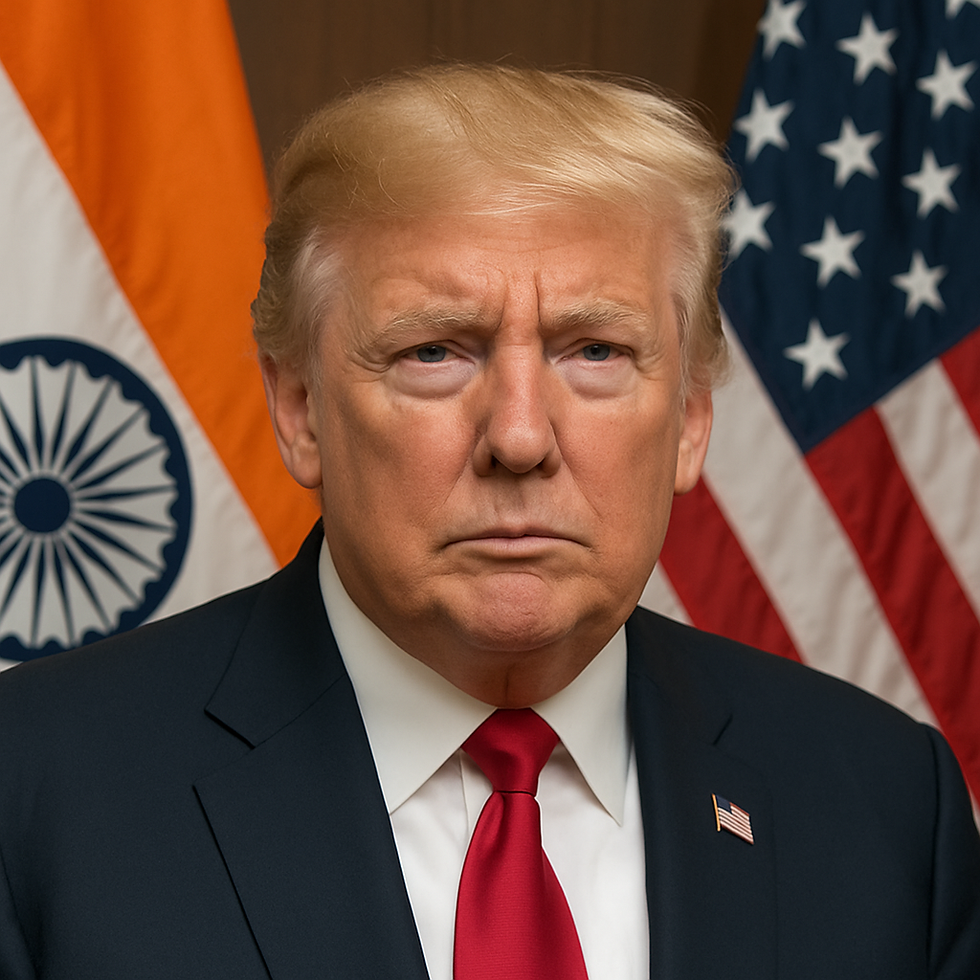Trump Tariffs on India – Implications
- Lakshay Sharma
- Aug 13
- 4 min read
Updated: Sep 17

Overview of the Tariffs
In late July 2025, U.S. President Donald Trump announced a 25% import tax (called a tariff) on a wide range of goods from India. Just days later, he added another 25% penalty tax, tallying the total tariffs to 50% on many products going from India to the U.S.
These tariffs were introduced for two main reasons:
Market Access Disputes – The U.S. says India makes it hard for American products to enter its market by taxing them heavily. India resisted opening its sensitive agricultural and dairy sectors to U.S. exports. The U.S. viewed these as trade barriers and accused India of maintaining protectionist policies.
Strategic & Political Pressure - India’s Continued Imports of Russian Oil The U.S. sought to apply geopolitical pressure on Russia by punishing its trading partners like India for sustaining its oil revenue, explicitly because India continued to buy Russian oil and energy supplies despite Western sanctions, amidst the war in Ukraine.
Critics say this move breaks the usual global trade rules (set by the WTO) and shows the U.S. is now taking a more overbearing, bilateral approach to trade.

Impact on India’s Economy
Exports
The U.S. is India’s biggest export customer, accounting for 16% of foreign exports (worth nearly $87 billion in 2024). The new tariffs hit about two-thirds of those exports. Many Indian goods will instantly become 30–35% more expensive in the U.S. compared to goods from rival exporters like Vietnam or Bangladesh.
Experts warn that this could make over half of India’s U.S. exports uncompetitive, meaning American buyers may switch to cheaper suppliers.
GDP Growth
India’s trade with the U.S. adds about 1.2% to the country’s GDP. If even half of that is lost, growth could slow by 0.25–0.4 % points. If the 50% tariffs last a full year, the slowdown could be 0.5–0.8 % points, which is a marginal hit for an economy aiming for around 6% growth.
Implication on Market and Currency
The Indian rupee dropped about 2% right after the news, as investors feared less money coming into the country.
Foreign investors pulled back from Indian stocks, making the market perform worse than other Asian countries with better U.S. trade relations.
Analysts say this tariff issue adds uncertainty to an already expensive stock market.
The Reserve Bank of India has signaled readiness to intervene to stabilize the rupee.

Industries at Risk
Textiles and Clothing
The U.S. is a huge buyer of Indian clothes, bedsheets, and fabrics. Many Indian textile companies get 40–70% of their sales from the U.S. With already thin profit margins, these businesses could lose orders to competitors who face lower U.S. tariffs.
Gems and Jewelry
India is one of the world’s largest producers of cut diamonds and gold jewelry, much of which is sold to the U.S. The new tariffs could cause a sudden stop in sales, hitting millions of workers in the industry.
Auto Parts
Indian companies supply parts to U.S. car makers and retailers. Higher costs from tariffs could make these products less attractive, reducing orders. Indian automakers themselves are less affected since they sell mostly in other regions.
Pharmaceuticals
The U.S. buys nearly one-third of India’s medicine exports, especially generic drugs. This sector isn’t targeted yet, but if it is, profits could fall by 2–8%.
Other Sectors
Chemical manufacturers, oil refiners (due to Russian oil penalties), and solar equipment exporters could also face problems.
Political Fallout
The tariffs have soured U.S.–India relations, reversing earlier goodwill between Trump and Prime Minister Modi. India’s foreign ministry called the decision “extremely unfortunate” and defended Russian oil imports as an economic necessity. Domestically, nationalist sentiment has surged:
Calls for boycotts of American brands have gained traction.
Modi has publicly urged self-reliance and prioritization of Indian-made goods.
However, India has avoided immediate retaliatory tariffs, instead keeping the door open for negotiations.

India’s Response
Negotiations – Quiet diplomatic talks are underway to explore compromises, such as phased Russian oil reductions or lowering some Indian import barriers in exchange for tariff relief.
Help for Exporters – The government may give financial support, tax breaks, and special schemes to help industries hit by the tariffs.
Trade Diversification – India is speeding up trade deals with the EU, UK, and Gulf countries so it’s less dependent on the U.S.
Legal Action – India may take the case to the WTO, arguing that the tariffs break global trade rules.
Global Impact
This marks a return to U.S. protectionism, similar to Trump’s earlier trade war with China.
Other countries might also start breaking WTO rules, increasing trade tensions.
Asian competitors like Vietnam and Indonesia could gain U.S. orders that India loses.
American consumers could face higher prices for some goods.
India might strengthen ties with Russia and China if relations with the U.S. worsen.
Bottom Line
The 50% tariff is a serious challenge for India’s economy, affecting exports, jobs, and international relations. If a compromise is reached soon, the damage could be limited. But if the tariffs stay, they could slow India’s growth, weaken the rupee, and push India to change its trade partnerships.
This dispute is more than just a fight between two countries—it’s part of a bigger trend toward protectionism that could reshape how global trade works.



Comments